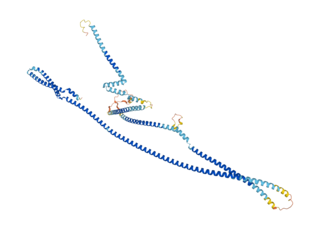
Cux1 is a homeodomain protein that in humans is encoded by the CUX1 gene.

Golgi-associated PDZ and coiled-coil motif-containing protein is a protein that in humans is encoded by the GOPC gene.

Coatomer subunit alpha is a protein that in humans is encoded by the COPA gene.

Transmembrane emp24 domain-containing protein 10 is a protein that in humans is encoded by the TMED10 gene.

Golgin subfamily A member 4 is a protein that in humans is encoded by the GOLGA4 gene.

ADP-ribosylation factor 5 is a protein that in humans is encoded by the ARF5 gene.

ADP-ribosylation factor-like protein 1 is a protein that in humans is encoded by the ARL1 gene.

Cytoplasmic dynein 1 intermediate chain 1 is a protein that in humans is encoded by the DYNC1I1 gene.

BET1-like protein is a protein that in humans is encoded by the BET1L gene.

Conserved oligomeric Golgi complex subunit 7 is a protein that in humans is encoded by the COG7 gene.

Golgin subfamily A member 5 is a protein that in humans is encoded by the GOLGA5 gene.

GRIP and coiled-coil domain-containing protein 2 is a protein that in humans is encoded by the GCC2 gene.

Conserved oligomeric Golgi complex subunit 5 is a protein that in humans is encoded by the COG5 gene.

Golgi resident protein GCP60 is a protein that in humans is encoded by the ACBD3 gene.

AP-4 complex subunit mu-1 is a protein that in humans is encoded by the AP4M1 gene.

Conserved oligomeric Golgi complex subunit 1 is a protein that in humans is encoded by the COG1 gene.

Conserved oligomeric Golgi complex subunit 2 is a protein that in humans is encoded by the COG2 gene.

SEC23-interacting protein is a protein that in humans is encoded by the SEC23IP gene.

Giantin or Golgin subfamily B member 1 is a protein that in humans is encoded by the GOLGB1 gene. Giantin is located at the cis-medial rims of the Golgi apparatus and is part of the Golgi matrix that is responsible for membrane trafficking in secretory pathway of proteins. This function is key for proper localisation of proteins at the plasma membrane and outside the cell which is important for cell function that is dependent on for example receptors and the extracellular matrix function. Recent animal model knockout studies of GOLGB1 in mice, rat, and zebrafish have shown that phenotypes are different between species ranging from mild to severe craniofacial defects in the rodent models to just minor size defects in zebrafish. However, in adult zebrafish a tumoral calcinosis-like phenotype was observed, and in humans such phenotype has been linked to defective glycosyltransferase function.

Golgin A7 is a protein that in humans is encoded by the GOLGA7 gene. It is an acylated Golgi protein that interacts with GCP170 protein.




















